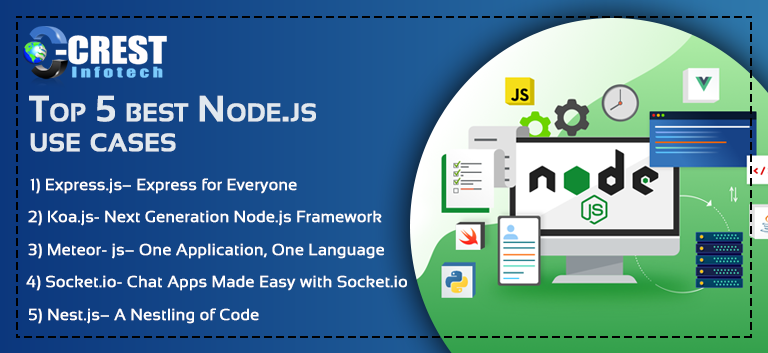Apart from its speed, NodeJs has a number of features that developers can use in a variety of applications. Let’s take a look at some of NodeJs’ most useful applications.
Real-time applications
When asked, “What is the best use case for NodeJs Development?” The real-time application is then the solution. This is one application where NodeJs excels. Let’s look at why NodeJs is so common for real-time apps:
- NodeJs allows you to reuse and share NodeJs bundles, which are used to store library code.
- As a result, data sync between the server and the client is fast.
- It can easily handle a large number of client requests.
In a nutshell, if real-time data processing and scalability are two important considerations for your project, NodeJs is the best technology to use.
Not only that, but there are several other reasons why NodeJs should be used in real-time application creation. So, if anyone asks why you choose NodeJs for a real-time application, here’s why.
Event-based server
Multiple real-time users must be dealt with in real-time applications. That’s where NodeJs comes in, as it allows for non-blocking responses that are based on an event-driven server.
Data sync
The non-blocking I/O function is used by a NodeJs developer. It also allows for quick data transfer between the client and the server.
Proxy server
Node is the best choice whenever intermediary administrators are needed. To use NodeJs as a proxy server, a developer must add 20 lines of code. After that, the framework would be well-suited for streaming data from different sources.
Other prominent real-time application use cases
The number of real-time device use cases is enormous. As a result, it’s critical to address some of the most common real-time application use cases, including:
Application monitoring dashboard
Another famous NodeJs application is monitoring website users and visualising all of their real-time interactions.
You can obtain real-time statistics about your users here.
You can take things a step further by introducing targeted interactions with your users by simply opening the contact channel when your users hit a particular point in the funnel.
This is extremely beneficial to every company because it allows them to see what their customers or guests are doing in real time. It also allows them to see their interactions in real time. This data are important, and companies will use them to develop their services. It’s all possible thanks to NodeJs’ real-time and two-way sockets.
System monitoring dashboard
Let’s take a look at the infrastructure side of things now. Consider a SaaS provider who wants to provide their users with a service-monitoring page similar to GitHub’s status page.
The NodeJs event-loop allows you to create a powerful web-based dashboard that can asynchronously check the status of services. With the support of WebSockets, it also moves data to the client.
You will use this technology to report on the state of both public and internal facilities in real time.
Consider a Network Operations Center (NOC) controlling applications in a financial institution, a telephone operator, or a cloud/network/hosting provider, all of which are run on an open web stack with WebSockets and NodeJs instead of Java or Java Applets.
Video streaming
Streaming is the process of sending large volumes of data in small batches rather than in one large batch. For creating video streaming applications, NodeJs is an excellent alternative. It’s ideal because it comes with built-in video streaming modules.
It also allows for the development of both writable and readable data sources. You can also process the files as they are being uploaded with NodeJs.
Highly scalable applications
NodeJs has been the platform of choice for all applications and systems that see a steady increase in their user base. NodeJs is used by companies such as Walmart, PayPal, Uber, Netflix, LinkedIn, and many others because it allows for smooth scalability.
NodeJs’ cutting-edge technology includes features such as cluster modules. It enables load balancing across multiple CPU cores, making it easier to deliver desired results through smaller modules without depleting RAM.
Not only that, but NodeJs uses a non-blocking event-loop system that allows servers to process requests in real time.
Chat
A chat application is the most common example of a real-time and multi-user application. Since it’s a data-intensive, high-traffic, and lightweight application that runs through many distributed devices, a chat application is one of the best use cases for NodeJs.
Server-Side Proxy
In web Development applications, a third-party proxy may cause havoc. Many popular third-party servers, such as Nginx and HAProxy, struggle to handle multiple requests at times.
NodeJs can be a lifesaver because it can easily be used as a server-side proxy because it can handle a large number of simultaneous connections while remaining non-blocking.
BBC News is an example of a NodeJS application. The BBC news website interacts with a number of third-party servers and gathers information from a variety of outlets. NodeJs assists in proxying various providers with varying response times.
If your proxying infrastructure isn’t up to par, or if you need a solution for local growth, you can use NodeJs.
It means you can use the NodeJs development server for assets and stubbing API requests to build a client-side app. While in development, dedicated proxy servers like HAProxy and nginx can handle such interactions.
You can Hire NodeJs Developer for part time, full time and scheduled time of period for your business development process. Contact Crest Infotech to know more about NodeJs Development services in Details.



